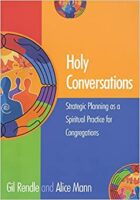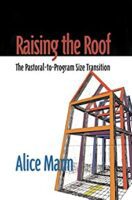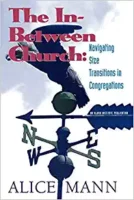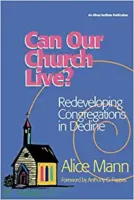[This article is part 5 of the series Crunch Time for Small Congregations.]
When faced with the prospect that they can no longer support a full-time, seminary-trained pastor or rabbi, many congregations set a goal that they will grow to a size where supporting this style of ministry is once again possible. In those cases where the current financial crunch is a temporary glitch in an otherwise healthy picture of numerical, spiritual, and financial growth, a size-change initiative may be viable.
In the overwhelming majority of cases, however, the crunch has been under way for years, if not decades, and has only reached a “tipping point” due to the latest stress on the system—an economic downturn, further population shift, denominational conflict, or internal conflict in the congregation. Setting a goal of growth in this situation may be, in effect, wishful thinking. Such goals are often set at the time a new pastor or rabbi is being selected, on the assumption that if the congregation simply had “better” clergy than before, the situation would be reversed.
Long-term trends of decline are not easily reversed. They usually signal that the congregation’s whole sense of identity and purpose—which may have been well suited to its community context in some previous decade—is no longer a viable foundation for congregational vitality and viability. In this situation, fine-tuning the program, trying a new curriculum, or bringing in guitars won’t make any lasting difference to the basic trend—fundamental change will be needed.
According to George Bullard only a minority of congregations that have existed more than 25-30 years actually make the changes needed to launch a new era of vital ministry (he calls this “redevelopment”). Bullard’s “Spiritual Strategic Journey” tutorial identifies things your congregation can do to improve the odds of successful transformation, and lists different redevelopment pathways you may want to consider.
Often the dominant motivation for a “redevelopment” effort is to return the congregation to a remembered status-quo—and particularly, to make sure we have “our own” pastor or rabbi once again. Such thinking may betray a wish to bring back the past, or to return to a moment when things didn’t seem so hard because the clergy took most of the responsibility for the congregation’s life (or at least took the blame if things went wrong).
Some congregations negotiate a three-year subsidy plan with their denomination, aimed at bringing the congregation to the point where it can support a conventional structure of ministry (full-time, seminary-trained clergy; a building of our own; and a viable, if small, program of ministries.) Such plans are unlikely to lead to self-support if there is not an agreed redevelopment strategy that has been tested for realism with other church leaders who have done this work in a similar context.
A related approach is to subsidize a full-time clergy position from the endowment. In the presence of a well-researched redevelopment strategy that has the necessary political support from influential members, this could be a reasonable step— particularly if it is accompanied by a financial plan that shows how the congregation will pay for current ministry from current income in the near future.
In reality, most such plans for self-support fall into the category of “wishful thinking”—they do not involve the fundamental changes necessary to create sustainable ministries; or they cannot be fully implemented due to ongoing resistance from influential members; or the clergy and lay leaders involved do not have the background and skills to connect with the new population groups that might make the ministry viable. As a result, such plans often amount to a decision to “keep doing what we are familiar with until we have spent down all our reserves.”
[Return to the series Crunch Time for Small Congregations.]
Alice Mann is a leading consultant, educator, and author in the field of congregational development, whose work has focused on strategic planning, breaking through size plateaus, creating new pathways for small and struggling churches, and helping congregations to discern and care for the “soul” of their local community. Mostly retired from consulting and teaching, Alice is an active member of a small, engaged urban congregation and also offers leadership for faith-based community organizing in her region. She occasionally accepts one-time conversations with former clients and other church leaders on issues close to her heart.
Books by Alice Mann





